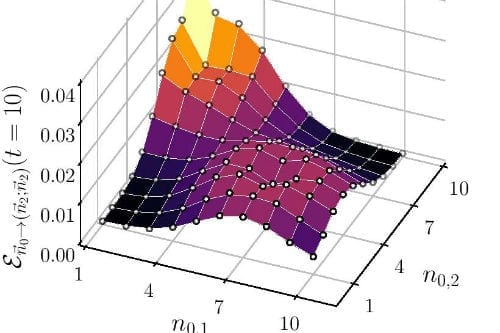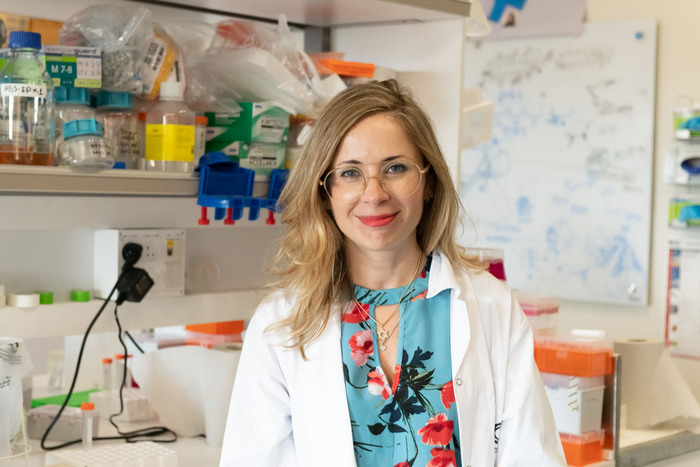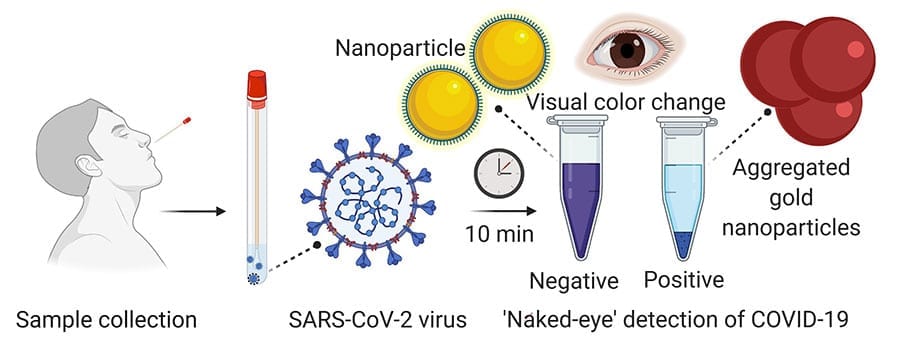
via University of Bristol
A Bristol academic has achieved a milestone in statistical/mathematical physics by solving a 100-year-old physics problem – the discrete diffusion equation in finite space.
The long-sought-after solution could be used to accurately predict encounter and transmission probability between individuals in a closed environment, without the need for time-consuming computer simulations.
In his paper, published in Physical Review X, Dr Luca Giuggioli from the Department of Engineering Mathematics at the University of Bristol describes how to analytically calculate the probability of occupation (in discrete time and discrete space) of a diffusing particle or entity in a confined space – something that until now was only possible computationally.
Dr Giuggioli said: “The diffusion equation models random movement and is one of the fundamental equations of physics. The analytic solution of the diffusion equation in finite domains, when time and space is continuous, has been known for a long time.
“However, to compare model predictions with empirical observations, one needs to study the diffusion equation in finite space. Despite the work of illustrious scientists such as Smoluchowski, Pólya, and other investigators of yore, this has remained an outstanding problem for over a century—until now.
“Excitingly, the discovery of this exact analytic solution allows us to tackle problems that were almost impossible in the past because of the prohibitive computational costs.”
The finding has far-reaching implications across a range of disciplines and possible applications include predicting molecules diffusing inside cells, bacteria roaming in a petri dish, animals foraging within their home ranges, or robots searching in a disaster area.
It could even be used to predict how a pathogen is transmitted in a crowd between individuals.
Solving the conundrum involved the joint use of two techniques: special mathematical functions known as Chebyshev polynomials, and a technique invented to tackle electrostatic problems, the so-called method of images.
This approach allowed Dr Giuggioli to construct hierarchically the solution to the discrete diffusion equation in higher dimension from the one in lower dimensions.
The Latest Updates from Bing News & Google News
Go deeper with Bing News on:
Transmission probability
- Why I Am Glad I Bought More Tesla Stock
Tesla sales and earnings may improve considerably, and has the potential for significant growth in various segments. Read why I feel TSLA stock is a strong buy.
- Playbook PM: How SCOTUS might save Trump from his biggest trial
SCOTUS WATCH — The Supreme Court today took up the explosive question of how far DONALD TRUMP’s presidential immunity from criminal prosecution extends — a complex legal question surrounding the ...
- Pentagon can benefit from robust photonics infrastructure in Europe
One such technology is optical communication. Though the U.S. is investing in domestic laser R&D, the leaders in the field among its allies are in Europe. Photonics21, the European technology platform ...
- Here's Why Exelon (EXC) is a Strong Momentum Stock
For new and old investors, taking full advantage of the stock market and investing with confidence are common goals. Zacks Premium provides lots of different ways to do both. Featuring daily updates ...
- Bird flu spreads in the US: Is it safe to eat eggs?
The United States is facing an outbreak of H5N1 bird flu that has spread to cows and humans. How is this affecting dairy products and eggs?
Go deeper with Google Headlines on:
Transmission probability
[google_news title=”” keyword=”transmission probability” num_posts=”5″ blurb_length=”0″ show_thumb=”left”]
Go deeper with Bing News on:
Covid-19 transmission
- Covid-19 Pandemic Led To Growing Acceptance Of Doctors Withholding Treatment
According to a new study there is a steadily growing acceptance of the view that it could be ethically acceptable for doctors to refuse care.
- Scientists discover higher levels of CO₂ increase survival of viruses in the air and transmission risk
A new study has revealed for the first time the vital role carbon dioxide (CO2) plays in determining the lifespan of airborne viruses—namely SARS-CoV-2, the virus that causes COVID-19. It clearly ...
- Did California's pediatric COVID-19 vaccination program reduce reported cases and hospitalizations?
Changes in the incidence of severe acute respiratory syndrome coronavirus 2 (SARS-CoV-2) and related hospitalizations.
- OTA Transmission Platform Market Ethnography Techniques Enhancing Customer Engagement through Deeper Understanding
Request To Download Free Sample of This Strategic Report @- OTA Transmission Platform Market is valued at approximately USD 95.6 million in 2019 and is anticipated to grow with a healthy growth rate ...
- COVID-19 pandemic alters view that doctors are obligated to provide care: Study
The unique circumstances arising from the COVID-19 pandemic altered a long-held convention that doctors provide care regardless of personal risk.
Go deeper with Google Headlines on:
Covid-19 transmission
[google_news title=”” keyword=”Covid-19 transmission” num_posts=”5″ blurb_length=”0″ show_thumb=”left”]










